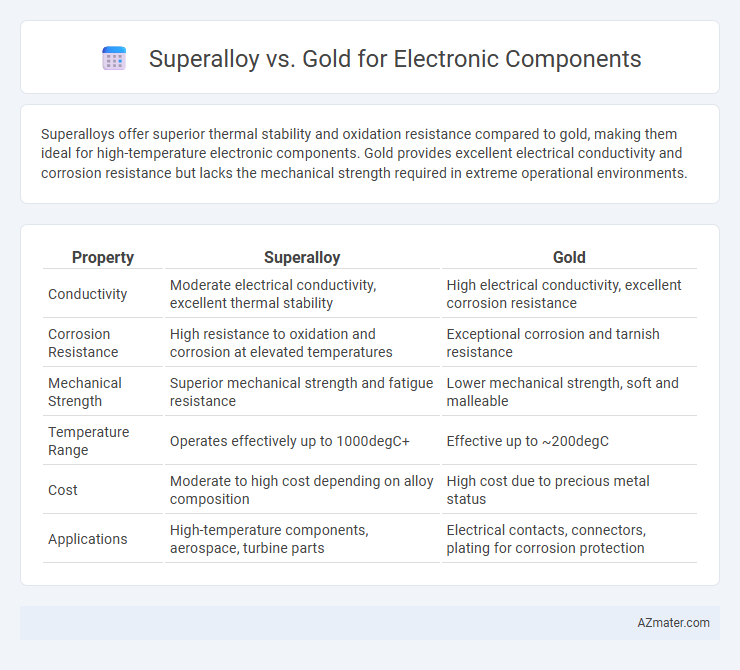Superalloys offer superior thermal stability and oxidation resistance compared to gold, making them ideal for high-temperature electronic components. Gold provides excellent electrical conductivity and corrosion resistance but lacks the mechanical strength required in extreme operational environments.
Table of Comparison
| Property | Superalloy | Gold |
|---|---|---|
| Conductivity | Moderate electrical conductivity, excellent thermal stability | High electrical conductivity, excellent corrosion resistance |
| Corrosion Resistance | High resistance to oxidation and corrosion at elevated temperatures | Exceptional corrosion and tarnish resistance |
| Mechanical Strength | Superior mechanical strength and fatigue resistance | Lower mechanical strength, soft and malleable |
| Temperature Range | Operates effectively up to 1000degC+ | Effective up to ~200degC |
| Cost | Moderate to high cost depending on alloy composition | High cost due to precious metal status |
| Applications | High-temperature components, aerospace, turbine parts | Electrical contacts, connectors, plating for corrosion protection |
Introduction to Superalloys and Gold in Electronics
Superalloys, primarily composed of nickel, cobalt, or iron, offer exceptional mechanical strength, corrosion resistance, and high-temperature stability, making them ideal for demanding electronic components in aerospace and industrial applications. Gold, known for its excellent electrical conductivity and resistance to oxidation, is extensively used in connectors, bonding wires, and circuit boards to ensure reliable signal transmission and long-term durability. The choice between superalloys and gold hinges on balancing factors like mechanical performance, thermal stability, and electrical conductivity specific to the electronic component requirements.
Electrical Conductivity: Superalloy vs Gold
Gold exhibits superior electrical conductivity compared to superalloys, making it a preferred choice for high-performance electronic components requiring low resistance and reliable signal transmission. Superalloys, composed mainly of nickel, cobalt, or iron, typically offer lower electrical conductivity but excel in mechanical strength and resistance to corrosion and high temperatures. The trade-off between gold's exceptional conductivity and superalloy's durability often dictates the material selection in advanced electronic applications.
Thermal Stability and Heat Resistance
Superalloys exhibit superior thermal stability and heat resistance compared to gold, making them ideal for electronics components operating at extreme temperatures. Their ability to maintain mechanical strength and resist oxidation above 700degC contrasts with gold's lower melting point of 1064degC and susceptibility to diffusion at elevated temperatures. This makes superalloys more reliable for high-performance applications requiring long-term thermal endurance and structural integrity.
Corrosion and Oxidation Resistance
Superalloys exhibit superior corrosion and oxidation resistance compared to gold, making them ideal for high-temperature and harsh environments in electronics components. Their complex composition, often including elements like nickel, cobalt, and chromium, forms a stable oxide layer that protects the material from degradation. Gold, while highly conductive and corrosion-resistant in many applications, lacks the high-temperature stability and protective oxide scale offered by superalloys.
Mechanical Strength and Durability
Superalloys exhibit superior mechanical strength and durability compared to gold, making them ideal for high-stress electronic components subjected to extreme temperatures and mechanical loads. Gold offers excellent electrical conductivity and corrosion resistance but lacks the hardness and fatigue resistance found in superalloys like Inconel or Hastelloy. Selecting superalloys enhances electronic component lifespan and performance in demanding environments, ensuring structural integrity and long-term reliability.
Cost Comparison: Superalloy versus Gold
Superalloys offer a cost-effective alternative to gold in electronics components, with prices significantly lower per kilogram, reducing overall manufacturing expenses. Gold's premium cost, driven by its rarity and excellent conductivity, often leads to higher production costs despite superior corrosion resistance and electrical performance. Selecting superalloys can optimize budgets without substantially compromising durability and electrical efficiency in many electronic applications.
Application Areas in Modern Electronics
Superalloys, known for exceptional temperature resistance and mechanical strength, are widely used in aerospace electronics, high-performance sensors, and power electronics requiring thermal stability and durability. Gold, prized for its excellent electrical conductivity and corrosion resistance, is commonly applied in high-reliability connectors, bonding wires, and semiconductor device contacts within consumer electronics and telecommunications. The choice between superalloy and gold depends on specific application demands such as thermal management and electrical performance in modern electronics.
Manufacturing Processes and Scalability
Superalloys, composed primarily of nickel, cobalt, or iron, offer superior high-temperature strength and corrosion resistance, making them ideal for advanced electronic components that require durability under harsh conditions. Manufacturing processes for superalloys often involve complex methods such as powder metallurgy, directional solidification, and precision machining, which can limit scalability compared to gold's simpler electroplating and wire bonding techniques. Gold remains favored in electronics for its excellent electrical conductivity and ease of manufacturing at scale, supporting mass production through established methods like deposition and etching, despite higher material costs and lower mechanical strength relative to superalloys.
Environmental and Sustainability Considerations
Superalloys, known for their exceptional thermal and mechanical stability, offer enhanced durability and longer lifespan for electronic components, reducing waste and the environmental impact of frequent replacements. Gold, while highly conductive and corrosion-resistant, involves environmentally intensive mining processes that contribute to habitat destruction and significant carbon emissions. Transitioning to superalloys in electronics supports sustainability by lowering resource extraction demands and promoting component recyclability.
Future Trends in Electronic Component Materials
Superalloys offer superior thermal stability and mechanical strength compared to gold, enabling electronic components to perform reliably in high-temperature and high-stress environments of future aerospace and automotive applications. Advancements in nanostructured superalloys enhance electrical conductivity while maintaining corrosion resistance, positioning them as a promising alternative to traditional gold-based materials in microelectronics. Emerging trends emphasize integrating superalloys with flexible substrates and additive manufacturing to meet the growing demand for miniaturization and durability in next-generation electronic devices.

Infographic: Superalloy vs Gold for Electronics Component
 azmater.com
azmater.com